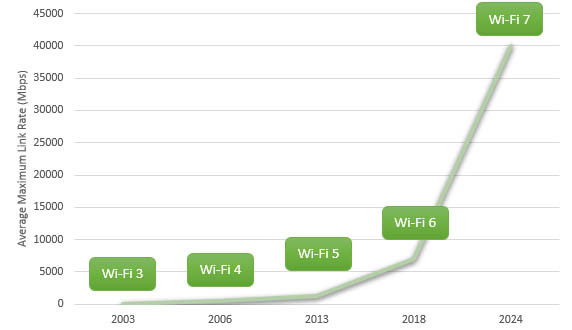Datalyst Blog
Slow Wi-Fi? Upgrade Your Business to Wi-Fi 7 and Prepare to be Blown Away
If it has been a few years since you have made any changes to your office’s wireless network, you and your employees may have noticed that it’s starting to feel a little slow in comparison to other types of network connections. No, it’s probably not your current Wi-Fi access point going bad, but it’s likely that it’s struggling to handle the office environment you have today, versus the office environment you had back when it was first installed.
The Evolution of Wireless Networking
Like most technology, Wi-Fi devices have evolved over the years to become faster and more efficient. Speed is the most obvious metric that we have seen increase over the years, but it’s actually not the most important. With each iteration of wireless technology standards (which the industry calls the 802.11 standard), not only has overall data throughput improved, but innovations have been made to allow for more connections at once, and the ability to handle “congestion” when a lot of devices are talking to each other and connecting to the network all at once.
Wi-Fi Speed Increases Over the Years

This alone makes the newer technology seem really impressive, but there are also a few things to consider as wireless technology advances.
What is Wi-Fi 7?
Although technically, Wi-Fi 7 devices have been around for most of 2023, being an early adopter doesn’t immediately give you blazing-fast speeds on all of your existing devices. Older laptops, tablets, smartphones, and other Wi-Fi-connected devices will cap out at whatever standard they were designed for. If you have an old laptop that only supports Wi-Fi 5, it won’t be able to take advantage of the speeds of Wi-Fi 6 or Wi-Fi 7. However, your wireless network overall will experience better latency and handle the increased number of devices that might be causing bottlenecks on your existing wireless.
Wi-Fi 7 (known as 802.11be Extremely High Throughput) can theoretically reach peak rates of over 40 Gbps, which is almost 5 times faster than Wi-Fi 6. Of course, this is in optimal conditions, but even in more normal circumstances users should see a boost if they have newer devices that support it. That’s the big caveat though that we mentioned before.
For most smartphones and tablets, you are out of luck when it comes to upgrading the Wi-Fi antenna to something more modern—you’ll just have to upgrade the whole device. Some laptops however, make it fairly easy for a technician to upgrade the wireless chip to something more modern. Just to be clear, Wi-Fi 7 routers and access points will still support older devices that use the older standards—you don’t need to worry about upgrading everything along with your network.
Upgrading directly to Wi-Fi 7 instead of a previous generation also helps future-proof your wireless network, as over time you will be replacing older devices, and the newer ones will come with the new standard. As businesses add more and more devices to their networks, from VoIP phones, BYOD (Bring Your Own Devices) like user smartphones and tablets, to IoT (Internet of Things) devices like smart appliances, lights, cameras, access control, monitoring and control devices, and a whole lot more, the airwaves start to get congested. Wi-Fi 7 has built-in technologies to automatically handle this more elegantly.
The exact way this works is pretty remarkable, considering we’re talking about radio waves and a ton of really advanced digital communication. On older Wi-Fi networks, when your laptop wants to transmit a signal to request to download a PDF that is attached to an email, it has to wait until the radio channel is free and not communicating with every other device that is connected. We’re talking about wait times that are extremely small, far less than a second, but when you have dozens of devices all talking at once, it makes it harder for any individual device to get its split-second to fire off the request. Wi-Fi 6 fixed that by allowing routers to divide the signal up into smaller units. Think of it like delivering a pizza—if you had three people on the same street order pizza delivery at the same time, it’s smarter to just send out one delivery person and have them stop at all three places as opposed to sending out three delivery people.
Wi-Fi 7 improves this even more by not only being able to break the signal into smaller delegated pieces, but decide how many “pieces” a certain device gets based on its need.
There are Prerequisites to Supporting Wi-Fi 7
Don’t just purchase a Wi-Fi 7 router and expect it to simply fix all of your wireless problems. You’ll need to ensure that your overall network itself can support the additional speed Wi-Fi 7 needs. It’s also a good idea to perform a wireless site survey to make sure the placement of the router and access points are optimal to support your office. If most of your wireless usage happens in a conference room, but there are obstacles blocking the signal, you won’t feel much benefit from the upgrade.
You’ll also want to make sure that the device is designed for business use and contains all of the security features your network needs to protect your data. Most consumer-based routers fall short, and enterprise-class routers require some configuration to get things squared away.
Let’s Make Wireless Work for You
Datalyst has long been among Massachusetts’ most trusted managed IT service providers. We help organizations like yours make the most out of technology, whether that is equipping your business with the most effective wireless solutions, improving business communications with VoIP, or handling the implementation and maintenance of your computers and laptops. When it comes to IT, we handle it all and we can help keep things running smoothly and secure.
Give us a call at (774) 213-9701 to get started.
Comments

